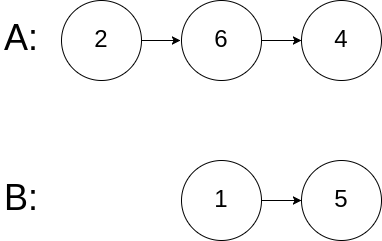160. Intersection of Two Linked Lists
Description
Given the heads of two singly linked-lists headA and headB, return the node at which the two lists intersect. If the two linked lists have no intersection at all, return null.
For example, the following two linked lists begin to intersect at node c1:

The test cases are generated such that there are no cycles anywhere in the entire linked structure.
Note that the linked lists must retain their original structure after the function returns.
Custom Judge:
The inputs to the judge are given as follows (your program is not given these inputs):
intersectVal- The value of the node where the intersection occurs. This is 0 if there is no intersected node.listA- The first linked list.listB- The second linked list.skipA- The number of nodes to skip ahead inlistA(starting from the head) to get to the intersected node.skipB- The number of nodes to skip ahead inlistB(starting from the head) to get to the intersected node.
The judge will then create the linked structure based on these inputs and pass the two heads, headA and headB to your program. If you correctly return the intersected node, then your solution will be accepted.
Example 1:

- Input: intersectVal = 8, listA = [4,1,8,4,5], listB = [5,6,1,8,4,5], skipA = 2, skipB = 3
- Output: Intersected at ‘8’
- Explanation: The intersected node’s value is 8 (note that this must not be 0 if the two lists intersect).
From the head of A, it reads as [4,1,8,4,5].
From the head of B, it reads as [5,6,1,8,4,5].
There are 2 nodes before the intersected node in A; There are 3 nodes before the intersected node in B.
→ Note that the intersected node’s value is not 1 because the nodes with value 1 in A and B (2nd node in A and 3rd node in B) are different node references. In other words, they point to two different locations in memory, while the nodes with value 8 in A and B (3rd node in A and 4th node in B) point to the same location in memory.
Example 2:

- Input: intersectVal = 2, listA = [1,9,1,2,4], listB = [3,2,4], skipA = 3, skipB = 1
- Output: Intersected at ‘2’
- Explanation: The intersected node’s value is 2 (note that this must not be 0 if the two lists intersect).
From the head of A, it reads as [1,9,1,2,4].
From the head of B, it reads as [3,2,4].
There are 3 nodes before the intersected node in A; There are 1 node before the intersected node in B.
Example 3:

- Input: intersectVal = 0, listA = [2,6,4], listB = [1,5], skipA = 3, skipB = 2
- Output: No intersection
- Explanation: From the head of A, it reads as [2,6,4]. From the head of B, it reads as [1,5]. Since the two lists do not intersect, intersectVal must be 0, while skipA and skipB can be arbitrary values.
Explanation: The two lists do not intersect, so return null.
Constraints:
- The number of nodes of listA is in the m.
- The number of nodes of listB is in the n.
- 1 <= m, n <= 3 * 104
- 1 <= Node.val <= 105
- 0 <= skipA <= m
- 0 <= skipB <= n
- intersectVal is 0 if listA and listB do not intersect.
- intersectVal == listA[skipA] == listB[skipB] if listA and listB intersect.
Follow up: Could you write a solution that runs in O(m + n) time and use only O(1) memory?
Submitted Code
# Definition for singly-linked list.
# class ListNode(object):
# def __init__(self, x):
# self.val = x
# self.next = None
class Solution(object):
def getIntersectionNode(self, headA, headB):
"""
:type head1, head1: ListNode
:rtype: ListNode
"""
listA, listB = [], []
while headA:
listA.append(headA)
headA = headA.next
while headB:
listB.append(headB)
headB = headB.next
if listA[-1] != listB[-1]: # 두 리스트의 마지막 노드가 다르다면 교차점 없음
return listA[-1].next
i = -1
nodeA = listA[i]
nodeB = listB[i]
while nodeA == nodeB and -i < min(len(listA), len(listB)):
nodeA = listA[i - 1]
nodeB = listB[i - 1]
i -= 1
if nodeA == nodeB:
return nodeA
else:
return listA[i + 1] # 마지막으로 같았던 노드
Runtime: 123 ms | Beats 92.52%
Memory: 42.49 MB | Beats 33.60%
리스트에 두 연결 리스트의 모든 노드를 저장한 후, 뒤에서부터 탐색하며 비교하는 방식을 사용했다. 𝑂(𝑛+𝑚)의 추가 공간이 필요한 단점이 있다.
Other Solutions
1st
class Solution:
def getIntersectionNode(self, headA: ListNode, headB: ListNode) -> Optional[ListNode]:
lista = headA # A 헤드 저장
listb = headB # B 헤드 저장
while lista != listb:
lista = lista.next if lista else headB # headA + headB
listb = listb.next if listb else headA # headB + headA
return listb
time complexity: 𝑂(𝑛+𝑚)
space complexity: 𝑂(1)
3 + 2와 2 + 3은 모두 5가 되는 것과 비슷한 원리를 이용하여 두 리스트의 길이를 맞추는 방법으로, 두 개의 포인터를 이용해 상수 공간만큼만 추가로 사용할 수 있다는 장점이 있다.
intersectVal = 8, listA = [4,1,8,4,5], listB = [5,6,1,8,4,5], skipA = 2, skipB = 3
B→→→→→→→→→→→→
A: 4 → 1 → 8 → 4 → 5 → n → 5 → 6 → 1 → 8
B: 5 → 6 → 1 → 8 → 4 → 5 → n → 4 → 1 → 8
A→→→→→→→→
n = null node ↳ intersection
Intersected at ‘8’



Leave a comment